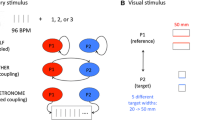Abstract
In recent years, researchers have made many new discoveries in the field of social interaction and have attempted to understand the mechanisms of interpersonal coordination. This research is marked by two streams: On the one hand, there are attempts to explain spontaneous, incidental interpersonal coordination in terms of the behavioral dynamics perspective, and on the other, to explain instructed, intentional interpersonal coordination in terms of joint action. Other paradigms fall somewhere between incidental and intentional coordination, e.g. task sharing paradigms. The present study has two major objectives. First, we wanted to explore to what extent a dyadic scenario for bimanual coordination mimics typical signatures of bimanual coordination performance as obtained in the classical individual scenario. Second, if such mimicking is obtained, we wanted to investigate the kind of information on which the coordination between the two individuals may be grounded. To do so, we used a bimanual aiming task, which enabled us to assess measurements of two levels of coordination: global (operating over longer periods of time) and local (operating on each particular trial). In Experiment 1, this task was performed in an individual and in a dyadic setting. In the dyadic scenario, we observed strong global coordination and weak local coordination. In Experiment 2, we replicated this pattern and showed that different kinds of feedback had no impact on interpersonal coordination. Based on these findings, we propose that interpersonal coordination in a non-rhythmic choice response task is based on weak interpersonal coordination.






Similar content being viewed by others
Notes
The baseline was computed only for the FB condition and only for participants who completed the FB condition as their first session. For this analysis, time series of one dyad had to be excluded because there was an error with the trial order and it was thus not comparable to the other data.
References
Atmaca S, Sebanz N, Prinz W, Knoblich G (2008) Action co-representation: the joint SNARC effect. Soc Neurosci 3:410–420
Diedrichsen J, Hazeltine E, Kennerley S, Ivry RB (2001) Moving to directly cued locations abolishes spatial interference during bimanual actions. Psychol Sci 12:493–498
Heuer H, Kleinsorge T, Spijkers W, Steglich C (2001) Static and phasic cross-talk effects in discrete bimanual reversal movements. J Mot Behav 33:67–85
Hove MJ, Risen JL (2009) It’s all in the timing: interpersonal synchrony increases affiliation. Soc Cogn 27:949–960
Kokal I, Gazzola V, Keysers C (2009) Acting together in and beyond the mirror neuron system. Neuroimage 47:2046–2056
Mechsner F, Kerzel D, Knoblich G, Prinz W (2001) Perceptual basis of bimanual coordination. Nature 414:69–73
Newman-Norlund RD, Bosga J, Meulenbroek RGJ, Bekkering H (2008) Anatomical substrates of cooperative joint-action in a continuous motor task: virtual lifting and balancing. Neuroimage 41:169–177
Oliveira FTP, Ivry RB (2008) The representation of action: insights from bimanual coordination. Curr Dir Psychol 17:130–135
Philipp AM, Prinz W (2010) Evidence for a role of the responding agent in the joint compatibility effect. Q J Exp Psychol (Colchester) 63:2159–2171
Poeppel E (2009) Pre-semantically defined temporal windows for cognitive processing. Philos Trans R Soc B Biol Sci 364:1887–1896
Richardson MJ, Marsh KL, Schmidt RC (2005) Effects of visual and verbal interaction on unintentional interpersonal coordination. J Exp Psychol Hum Percept Perform 31:62–79
Richardson MJ, Marsh KL, Isenhower RW, Goodman JRL, Schmidt RC (2007) Rocking together: dynamics of intentional and unintentional interpersonal coordination. Hum Mov Sci 26:867–891
Schmidt RC, Bienvenu M, Fitzpatrick PA, Amazeen PG (1998) A comparison of intra- and interpersonal interlimb coordination: coordination breakdowns and coupling strength. J Exp Psychol Hum Percept Perform 24:884–900
Schmidt RC, Fitzpatrick PA, Caron R, Mergeche J (2010) Understanding social motor coordination. Hum Mov Sci doi:10.1016/j.humov.2010.05.014
Schuch S, Tipper SP (2007) On observing another person’s actions: influences of observed inhibition and errors. Percept Psychophys 69:828–837
Sebanz N, Knoblich G (2009) Prediction in joint action: what, when, and where. Topics Cogn Sci 1:353–367
Sebanz N, Knoblich G, Prinz W (2003) Your task is my task: shared task representations in dyadic interactions. Lawrence Erlbaum Assoc Publ, Mahwah
Vesper C, Soutschek A, Schubo A (2009) Motion coordination affects movement parameters in a joint pick-and-place task. Q J Exp Psychol 62:2418–2432
Welsh TN, Elliott D, Anson JG, Dhillon V, Weeks DJ, Lyons JL, Chua R (2005) Does Joe influence Fred’s action? Inhibition of return across different nervous systems. Neurosci Lett 385:99–104
Wenke D, Atmaca S, Hollaender A, Baess P, Liepelt R, Prinz W (in press) What is shared in joint action? Issues of co-representation, response conflict, and agent identification. To appear in Rev Philo Psychol
Author information
Authors and Affiliations
Corresponding author
Rights and permissions
About this article
Cite this article
Jung, C., Holländer, A., Müller, K. et al. Sharing a bimanual task between two: evidence of temporal alignment in interpersonal coordination. Exp Brain Res 211, 471–482 (2011). https://doi.org/10.1007/s00221-011-2665-4
Received:
Accepted:
Published:
Issue Date:
DOI: https://doi.org/10.1007/s00221-011-2665-4




